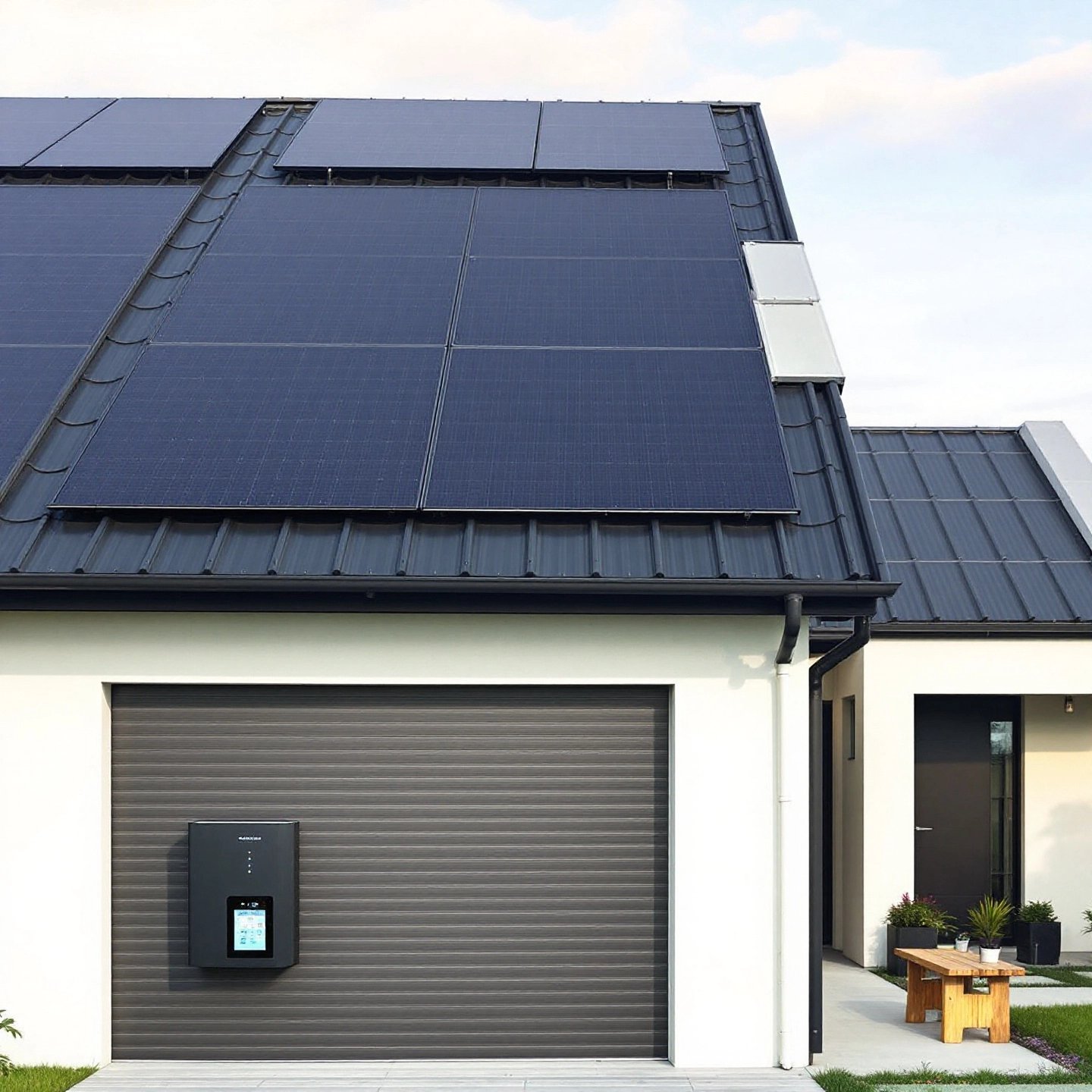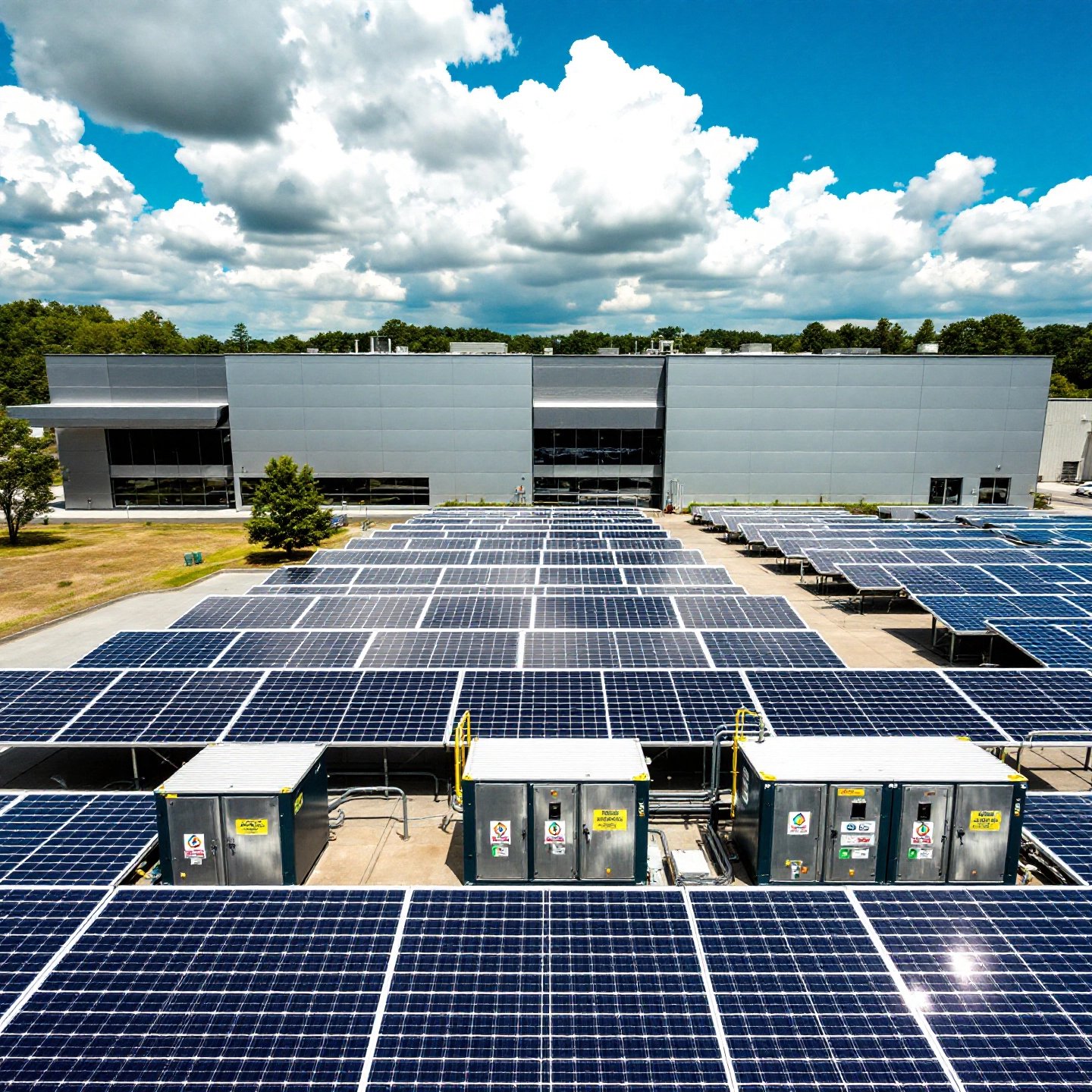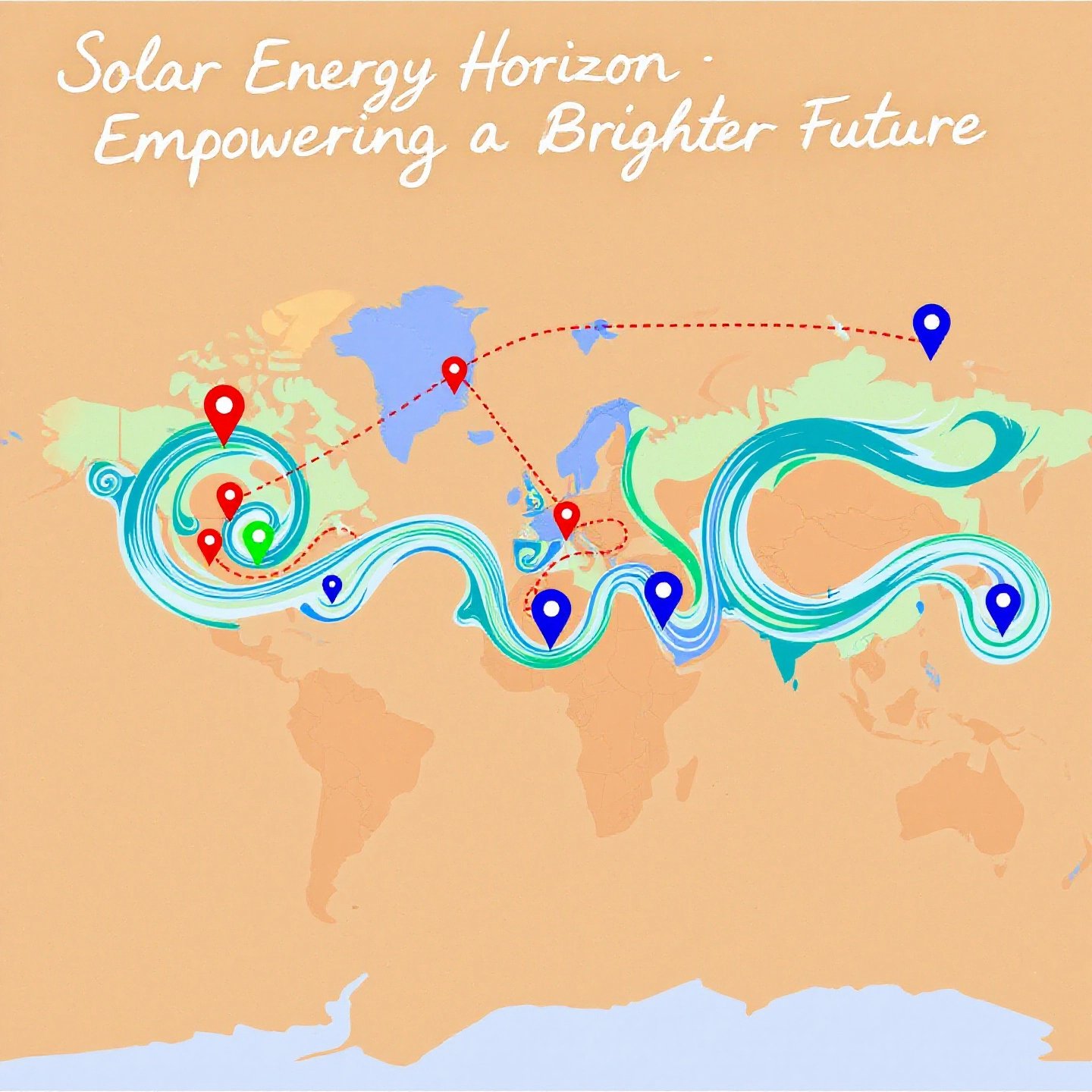Introduction to Solar Energy Storage
Imagine a world where energy is abundant, clean, and reliable. Sounds complex? Not with solar energy storage leading the charge in the renewable energy revolution. As we strive for a sustainable future, the significance of solar energy storage cannot be overstated. It plays a pivotal role in reducing carbon footprints, achieving energy independence, and stabilizing the grid.
Solar energy storage significance is evident in its ability to capture excess energy generated during sunny periods and store it for later use. This not only ensures a steady energy supply but also reduces reliance on fossil fuels, cutting down greenhouse gas emissions. By storing solar energy, we can create a buffer against the variability of solar power, ensuring that energy is available even when the sun isn’t shining.
Moreover, solar energy storage benefits extend to enhancing energy independence. By allowing individuals and businesses to store and use their own generated power, it reduces dependency on centralized power grids. This decentralization is particularly crucial in regions prone to power outages or those looking to cut ties with traditional energy providers.
Stabilizing the grid is another critical advantage. As renewable energy sources like solar and wind become more prevalent, the grid faces challenges due to their intermittent nature. Solar energy storage helps mitigate this by smoothing out the supply and demand fluctuations, thus maintaining grid stability and reliability.
As we delve deeper into this topic, we will explore residential and commercial applications, innovations, and strategies for implementing solar energy storage effectively. The journey towards a sustainable energy future is paved with such advancements, and understanding them is key to empowering our future today.
For more insights on how solar energy storage is shaping the future, visit Aurora Solar and Oilprice.com.
Understanding the Core Principles of Solar Energy Storage
When you think about solar energy storage, it might seem like a complex process. However, at its core, it involves capturing sunlight and converting it into electricity, which can then be stored for later use. Let’s delve into how this fascinating process works.
Solar Panel Energy Storage
At the heart of solar energy storage is the photovoltaic (PV) effect. Solar panels are composed of numerous PV cells, which are nonmechanical devices that convert sunlight directly into electricity. These cells are made of semiconductor materials that absorb photons from sunlight, dislodging electrons and creating an electrical charge imbalance. This imbalance generates a voltage potential, similar to a battery’s terminals, allowing electricity to flow when connected to an external circuit.
- Photovoltaic Effect: The process by which PV cells convert sunlight into electricity. It involves the absorption of photons and the movement of electrons within the semiconductor material.
- Energy Conversion: PV cells convert sunlight into direct current (DC) electricity, which can be used immediately or stored in batteries for later use.
- Battery Storage: The generated DC electricity can charge batteries, which store energy until it’s needed.
For more on how PV cells function, see the EIA’s explanation.
Battery Storage Chemistry
The storage of solar energy in batteries involves intricate chemical reactions. A typical battery consists of positive and negative electrodes with substances that facilitate these reactions. During charging, electrons are released from the negative electrode and absorbed by the positive electrode, creating a flow of electricity. This process is reversed during discharge, allowing stored chemical energy to be converted back into electrical energy.
- Charge Cycles: The process of charging and discharging a battery. It determines the battery’s lifespan and efficiency.
- Discharge Efficiency: A measure of how effectively a battery can release stored energy. High efficiency means less energy loss during the discharge process.
For a deeper dive into battery storage chemistry, refer to XZenergy’s guide.
Understanding these principles is crucial as we explore how solar energy storage balances generation and demand. This balance ensures a steady power supply, even when solar generation fluctuates. Next, we’ll examine how these principles translate into practical residential solutions, empowering everyday energy needs.

Exploring Residential Solutions for Everyday Needs
When you imagine harnessing the power of the sun for your home, you’re likely picturing a setup that’s not just efficient but also tailored to your specific needs. Home solar energy storage systems are at the forefront of this transformation, offering a variety of options to suit different requirements and budgets.
Understanding Battery Types and Capacities
In the realm of home solar energy storage, the choice of battery is pivotal. There are four main types of batteries commonly used:
- Lead-Acid Batteries: Known for their reliability and low cost, they are ideal for off-grid systems but require regular maintenance. They have a shorter lifespan compared to other types.
- Lithium-Ion Batteries: These are the most popular for residential use due to their high energy density, requiring minimal maintenance and offering a longer lifespan. However, they come with a higher upfront cost.
- Nickel Cadmium Batteries: Less common in homes, they are durable and can operate in extreme temperatures but are more suitable for large-scale applications.
- Flow Batteries: Emerging in the market, these batteries have a long lifespan and minimal fire risk but require significant space and are costly.
Choosing the right battery involves considering your home’s energy needs, budget, and the specific benefits each type offers. For more detailed insights, check out Solar Reviews.
System Configurations for Small-Scale or Off-Grid Scenarios
For homeowners looking to go off-grid or supplement their energy needs, system configuration is key. Small-scale systems often use DC-coupled batteries, which are more efficient when installed alongside new solar panels. AC-coupled batteries, on the other hand, are easier to integrate with existing solar setups, albeit with some energy efficiency loss due to multiple power conversions.
Renewable Energy Nexus offers solar panel products that integrate seamlessly with these configurations, helping you reduce your carbon footprint and utility bills. Explore their options here.
Solar Battery Maintenance and Safety Practices
Proper maintenance is crucial to ensure the longevity and efficiency of your solar battery system. Here are some best practices:
- Ensure even temperature distribution around batteries to prevent overheating or cold-related capacity loss.
- Regularly apply a non-hardening sealant to battery terminals to prevent corrosion.
- Maintain a full state-of-charge (SOC) at least every three weeks to prevent capacity degradation.
- Use temperature compensation features in charge controllers to adjust charging based on ambient conditions.
For more detailed maintenance tips, refer to Unbound Solar.
As we continue to explore solar energy storage, understanding these residential solutions helps empower everyday energy needs efficiently. Next, we’ll delve into commercial approaches, highlighting how large-scale efficiency can be achieved with solar energy storage systems.

Mapping Out Commercial Approaches for Large-Scale Efficiency
Imagine a bustling cityscape where skyscrapers and businesses are powered by the sun, their operations uninterrupted by grid fluctuations. This vision is becoming a reality thanks to commercial solar energy storage solutions. These systems are not only enhancing energy efficiency but also offering substantial economic and environmental benefits.
Commercial Solar Energy Storage Solutions
Commercial solar energy storage systems are designed to handle the high energy demands of businesses and industrial operations. These systems store excess solar energy generated during peak sunlight hours and release it during periods of high demand or low sunlight. This capability ensures a continuous power supply, reduces dependency on the grid, and protects against rising energy costs.
For instance, businesses can deploy large battery storage systems to manage energy use more effectively. According to EcoDirect, these systems can be scaled to meet specific energy needs, making them ideal for diverse applications such as microgrids, self-supply, and demand response.
Lessons from Large-Scale Solar Projects
Large-scale solar projects offer valuable insights into the implementation and benefits of commercial solar energy storage. For example, the Solar Energy Industries Association (SEIA) highlights that over 1,200 major energy storage projects are underway, representing more than 43,650 MWh of capacity. These projects demonstrate the potential for significant energy savings and reduced operational costs.
One key lesson from these projects is the importance of integrating smart energy management systems. These systems optimize energy usage by predicting demand patterns and adjusting storage and release accordingly, thus enhancing overall efficiency and sustainability.
Comparing Configurations: Capacity, Efficiency, and Scalability
| Configuration | Capacity | Efficiency | Scalability |
|---|---|---|---|
| Grid-Connected Systems | High | Moderate | Flexible |
| Off-Grid Systems | Variable | High | Limited |
| Hybrid Systems | Customizable | High | Highly Scalable |
As shown in the table, different configurations offer varying benefits. Grid-connected systems provide high capacity and flexibility, making them suitable for large businesses. Off-grid systems, while highly efficient, may have scalability limitations. Hybrid systems offer a balance, with high efficiency and scalability, making them ideal for businesses looking to optimize energy use and costs.
Understanding these configurations and their benefits can guide businesses in selecting the right solar energy storage solutions. As we move forward, the focus will shift to innovative methods and technologies that are shaping the future of solar energy storage, promising even greater efficiency and sustainability.

Highlighting Advanced Methods That Shape the Future
In the ever-evolving world of solar energy storage, innovations are constantly shaping the landscape. Imagine a future where molecular solar thermal energy storage systems are as commonplace as traditional solar panels. Sounds futuristic? Let’s explore how these advancements are setting the stage for tomorrow.
Innovations in Molecular Solar Thermal Energy Storage
Molecular solar thermal (MOST) energy storage represents a cutting-edge approach in the field of solar energy. This technology employs molecules that can absorb solar energy and store it as chemical energy, releasing it as heat when needed. The efficiency of MOST systems is remarkable, with theoretical limits suggesting energy storage efficiencies of up to 21% with optimized photoswitches, as reported in recent studies (source).
These systems are designed to overcome the limitations of traditional solar storage by utilizing liquid or solid-state molecular configurations, which can be conveniently transported and integrated into existing energy systems. This flexibility makes MOST a promising candidate for both residential and commercial applications.
Research Breakthroughs and Their Impact
Recent breakthroughs in molecular engineering have significantly enhanced the efficiency and durability of solar thermal energy storage systems. For instance, the development of multijunction MOST devices has shown potential to increase energy storage efficiency beyond traditional limits, as evidenced by experimental setups achieving efficiencies up to 0.1% in practical applications (source).
These advancements are not just theoretical. They are being tested in various experimental setups, including microfluidic chips that allow for precise control of molecular interactions. Such innovations are paving the way for more efficient and scalable solar energy storage solutions, promising to enhance the reliability of renewable energy sources.
Transitioning to Mainstream Adoption
The transition of these advanced technologies from laboratory settings to mainstream adoption is a crucial step. The key lies in addressing challenges such as cost, scalability, and integration with existing infrastructure. As research continues to address these hurdles, the potential for widespread adoption of advanced solar energy storage systems grows.
Moreover, the integration of smart energy management systems can further enhance the efficiency of these technologies, ensuring they meet the dynamic demands of modern energy grids. As these innovations become more accessible, they hold the promise of transforming how we store and use solar energy, making it a cornerstone of sustainable energy systems worldwide.
As we look to the future, the advancements in solar energy storage are not just about improving efficiency—they are about redefining our approach to renewable energy. Next, we’ll delve into the essential components that ensure the optimal performance of solar energy systems, continuing our journey towards a sustainable future.
Evaluating System Components for Optimal Performance
When it comes to solar energy storage, the right components can make all the difference in achieving efficiency and longevity. Imagine having a system that seamlessly integrates with your energy needs, optimizing every watt of power. Sounds ideal, right? Let’s explore the essential components that make this possible.
Inverters: The Heart of Solar Conversion
At the core of any solar energy system is the inverter, a device that converts the direct current (DC) electricity generated by solar panels into alternating current (AC) electricity used by most household appliances and the grid. Inverters are crucial for ensuring that solar energy systems can effectively integrate with existing electrical infrastructure.
- DC to AC Conversion: Inverters rapidly switch the direction of DC input to produce AC output, which is compatible with the grid (source).
- Types of Inverters: String inverters, microinverters, and central inverters each offer unique benefits. String inverters are cost-effective for small systems, while microinverters provide panel-level optimization, and central inverters are ideal for large-scale applications.
- Smart Inverters: These advanced devices can provide grid services such as frequency response and reactive power, enhancing grid stability and efficiency.
Charge Controllers: Protecting Your Batteries
Charge controllers are essential for regulating the voltage and current flowing from solar panels to batteries, preventing overcharging and extending battery life. They ensure that batteries receive the appropriate amount of power based on their state of charge and temperature.
- PWM vs. MPPT: Pulse Width Modulation (PWM) controllers are simple and cost-effective, while Maximum Power Point Tracking (MPPT) controllers are more efficient, extracting maximum power from solar panels (source).
- Voltage Regulation: Charge controllers adjust the voltage output to match the battery’s requirements, ensuring optimal charging conditions.
- Load Management: Some controllers offer load terminals for small appliances, providing low voltage disconnect to protect batteries from deep discharges.
Smart Monitoring Systems: Enhancing Efficiency
Smart monitoring systems play a crucial role in optimizing solar energy storage systems by providing real-time data on energy production, consumption, and storage. These systems help users make informed decisions about energy usage and system maintenance.
- Real-Time Data: Monitoring systems offer insights into system performance, allowing for timely maintenance and optimization.
- Remote Access: Many systems provide remote monitoring capabilities, enabling users to track their energy usage from anywhere via mobile apps or web interfaces.
- Efficiency Optimization: By analyzing usage patterns, monitoring systems can suggest ways to improve energy efficiency and reduce costs.
By understanding and selecting the right components, you can ensure that your solar energy storage system operates at peak efficiency and longevity. As we continue our exploration, the next chapter will delve into the cost factors and return on investment for different storage configurations, guiding you in making informed financial decisions.
Analyzing Cost and ROI for Different Storage Configurations
When considering solar energy storage, understanding the financial implications is crucial. Imagine investing in a system that not only reduces your carbon footprint but also pays for itself over time. Sounds promising, right? Let’s break down the cost factors and explore the potential return on investment (ROI) for both residential and commercial solar energy storage systems.
Initial Investment and Cost Factors
The initial cost of solar energy storage can vary significantly based on several factors. The type of battery chosen plays a pivotal role. For instance, lead-acid batteries are generally less expensive, ranging from $5,000 to $15,000, but require more maintenance and have a shorter lifespan. On the other hand, lithium-ion batteries, which are more durable and efficient, can cost between $7,000 and $30,000 (source).
Other factors influencing cost include the battery’s storage capacity, efficiency, and warranty. Larger capacity and higher efficiency batteries typically come with a higher price tag. Additionally, installation costs, which can vary based on system complexity and location, should be considered when budgeting for a solar energy storage system.
Maintenance and Government Incentives
Maintenance is another critical cost factor. Regular upkeep, such as ensuring temperature regulation and preventing corrosion, can extend the life of your batteries but may incur additional expenses. However, government incentives can offset some of these costs. Federal tax credits, for instance, can significantly reduce the upfront investment required for solar energy systems, including storage.
Calculating ROI: Residential and Commercial Perspectives
Calculating the ROI for solar energy storage involves comparing the initial investment against the savings generated over time. For residential systems, the key value proposition is the reduction in electricity bills. For example, a 6 kW solar system in Boulder, Colorado, might cost $16,000 after tax credits and save approximately $1,440 annually, leading to a payback period of around 11 years (source).
Commercial projects often have different dynamics due to larger scale and energy demands. These projects can benefit from economies of scale, potentially achieving a faster payback period. Moreover, businesses can leverage additional incentives such as accelerated depreciation and local rebates, enhancing the financial viability of solar storage investments.
Real-World Examples of Payback Periods
Consider a scenario where a commercial entity installs a large-scale solar storage system. By reducing reliance on grid electricity and minimizing peak demand charges, the business could achieve a payback period of 5 to 7 years. This period can vary based on factors such as local electricity rates, system size, and the availability of incentives.
Understanding these cost factors and ROI calculations is essential for making informed decisions about solar energy storage investments. As we continue, we will explore practical strategies to overcome common integration challenges, ensuring a seamless transition to solar energy storage systems.
Practical Strategies to Overcome Common Integration Challenges
When thinking about integrating solar energy storage into existing systems, challenges like permitting and grid interconnection often come to mind. These hurdles can feel daunting, but understanding and addressing them with best practices can pave the way for a successful transition.
Key Solar Integration Challenges
One of the primary challenges is the permitting process. Local governments require permits before installation, and this can vary significantly by jurisdiction, affecting both the timeline and cost of a solar project. The inspection process ensures compliance with building and safety codes, but errors or delays can inflate soft costs, which comprise a significant portion of overall expenses (source).
Another major challenge is grid interconnection. The interconnection queue for renewable projects is often lengthy, with projects waiting years for approval. This delay is compounded by the aging infrastructure of the national grid, which struggles to accommodate new renewable energy sources (source).
Best Practices for Mitigation
- Streamline Permitting: Work with local authorities to understand specific requirements and streamline documentation. Utilizing platforms like SolarAPP+ can automate and expedite the permitting process.
- Plan for Interconnection: Engage with utility companies early to understand grid requirements and potential costs. Consider energy storage solutions that can mitigate peak demand and reduce grid reliance.
- Leverage Technology: Use smart monitoring systems to optimize energy use and predict demand patterns, which can aid in smoother grid integration and enhance system efficiency.
- Stay Informed: Keep abreast of changes in regulations and technology advancements. Programs like SolSmart provide resources and recognition for reducing soft costs and streamlining solar access.
Support from Renewable Energy Nexus
Renewable Energy Nexus offers valuable resources and support to navigate these challenges. Their expertise in solar panel integration and commitment to sustainable solutions can help ensure a smoother transition. For more information on their offerings, visit Renewable Energy Nexus.
By adopting these best practices, you’ll notice a more efficient and cost-effective integration of solar energy storage systems. As we continue our exploration, the next chapter will assess market trends and forecast the global growth of solar energy storage, highlighting the collaborative efforts driving this momentum.

Looking Ahead to Sustainable Growth in Solar Energy Storage
Imagine a world where solar energy storage is not just a niche industry but a cornerstone of our global energy infrastructure. As we stand on the cusp of this reality, understanding the trends and factors driving solar market growth is essential. Let’s explore the landscape shaping the future of solar energy storage.
Current Solar Energy Storage Trends
The solar energy storage market is experiencing rapid expansion, driven by technological advancements and increasing demand for renewable energy solutions. According to recent trends, the U.S. solar and storage market is set to grow significantly in 2025, with residential and commercial sectors both contributing to this surge (source).
- Residential Growth: The residential sector is seeing a rise in solar installations, fueled by decreasing battery prices and increasing electricity tariffs. Households are increasingly adopting solar-plus-storage systems to manage energy costs and enhance energy independence.
- Commercial Expansion: The commercial sector is embracing solar energy storage to reduce operational costs and meet sustainability goals. New markets in the Midwest and Southeast U.S. are emerging as hotspots for solar adoption (source).
Policy and Investment Shifts
Government policies and investment trends play a pivotal role in shaping the solar energy storage landscape. The continuation and expansion of incentives like the Solar Investment Tax Credit (ITC) are crucial for maintaining market momentum. Policy stability is essential for investor confidence and long-term planning (source).
- Incentive Frameworks: Tax credits and subsidies remain vital in promoting solar adoption. The ITC has historically driven growth and is expected to continue supporting both residential and commercial projects.
- Investment in Innovation: Investment in research and development is crucial for advancing solar storage technologies. Breakthroughs in battery efficiency and new storage methods are anticipated to enhance the viability of solar energy systems.
Collaboration for Continued Momentum
Collaboration between innovators, governments, and end-users is key to sustaining growth in solar energy storage. By working together, stakeholders can address challenges such as regulatory hurdles and market integration.
- Public-Private Partnerships: These collaborations can drive innovation and streamline the deployment of solar technologies, ensuring they meet the needs of modern energy systems.
- Community Engagement: Involving local communities in solar projects can enhance acceptance and support, paving the way for smoother implementation and greater impact.
As we look to the future, the solar energy storage market is poised for transformative growth. By understanding the trends and factors at play, we can better navigate the path towards a sustainable energy future. In the next chapter, we’ll recap key takeaways and explore the importance of continued research and collaboration in advancing solar energy storage technologies.
Conclusion
As we draw this exploration to a close, it’s clear that solar energy storage is not merely a component of the renewable energy landscape—it’s a driving force for change. From residential applications that empower homeowners to commercial solutions that boost business efficiency, the advancements in solar energy storage are paving the way for a sustainable future.
Reflecting on the journey through residential and commercial perspectives, we’ve seen how the right choice of battery types, system configurations, and maintenance practices can make a significant difference. Whether it’s the dependable lead-acid battery for off-grid setups or the cutting-edge lithium-ion options for modern homes, each solution offers unique benefits tailored to diverse needs.
On the commercial front, the scalability and efficiency of solar storage systems are transforming how businesses approach energy management. The lessons from large-scale projects underscore the importance of integrating smart energy management systems to optimize performance and cost savings.
Looking to the future, the role of innovation cannot be overstated. Advanced methods like molecular solar thermal energy storage are not just theoretical—they represent the next leap in efficiency and sustainability. These solar advancements promise to redefine how we store and utilize solar power, making it more accessible and reliable than ever before.
However, achieving this vision requires more than just technological progress. It demands ongoing research, thoughtful design, and strategic partnerships. By fostering collaboration among innovators, governments, and communities, we can overcome challenges and accelerate the adoption of solar energy storage solutions.
To stay ahead in this dynamic field, it’s crucial to explore further resources and remain informed about the latest developments. Platforms like Renewable Energy Nexus offer valuable insights and products to guide you on this journey. By embracing these advancements, we can collectively empower a future where solar energy storage is at the heart of our sustainable energy systems.
Frequently Asked Questions
1. Is solar energy storage worth it?
Solar energy storage is worth considering for its ability to provide energy independence and reduce electricity costs. By storing solar power, you can avoid high grid electricity prices during peak times and ensure a reliable power supply during outages. Additionally, solar storage systems can enhance the return on investment by leveraging government incentives and tax credits.
2. What is the most efficient solar energy storage?
Lithium-ion batteries are currently the most efficient option for solar energy storage. They offer high energy density, longer lifespans, and require less maintenance compared to other types. Their efficiency in storing and releasing energy makes them ideal for both residential and commercial applications.
3. What are the types of solar energy storage systems?
Solar energy storage systems primarily use batteries, with the most common types being lead-acid and lithium-ion. Other emerging technologies include nickel cadmium and flow batteries. Each type has its advantages, with lithium-ion being favored for its efficiency and longevity.
4. How does solar energy storage benefit the grid?
Solar energy storage stabilizes the grid by balancing supply and demand fluctuations. It stores excess energy during peak solar production and releases it during high demand or low sunlight periods, reducing reliance on fossil fuels and enhancing grid reliability.
5. What are the cost factors of solar energy storage?
The cost of solar energy storage includes the initial investment in batteries, installation, maintenance, and potential savings from government incentives. Lithium-ion batteries, while more expensive upfront, offer better long-term value due to their efficiency and lifespan.



